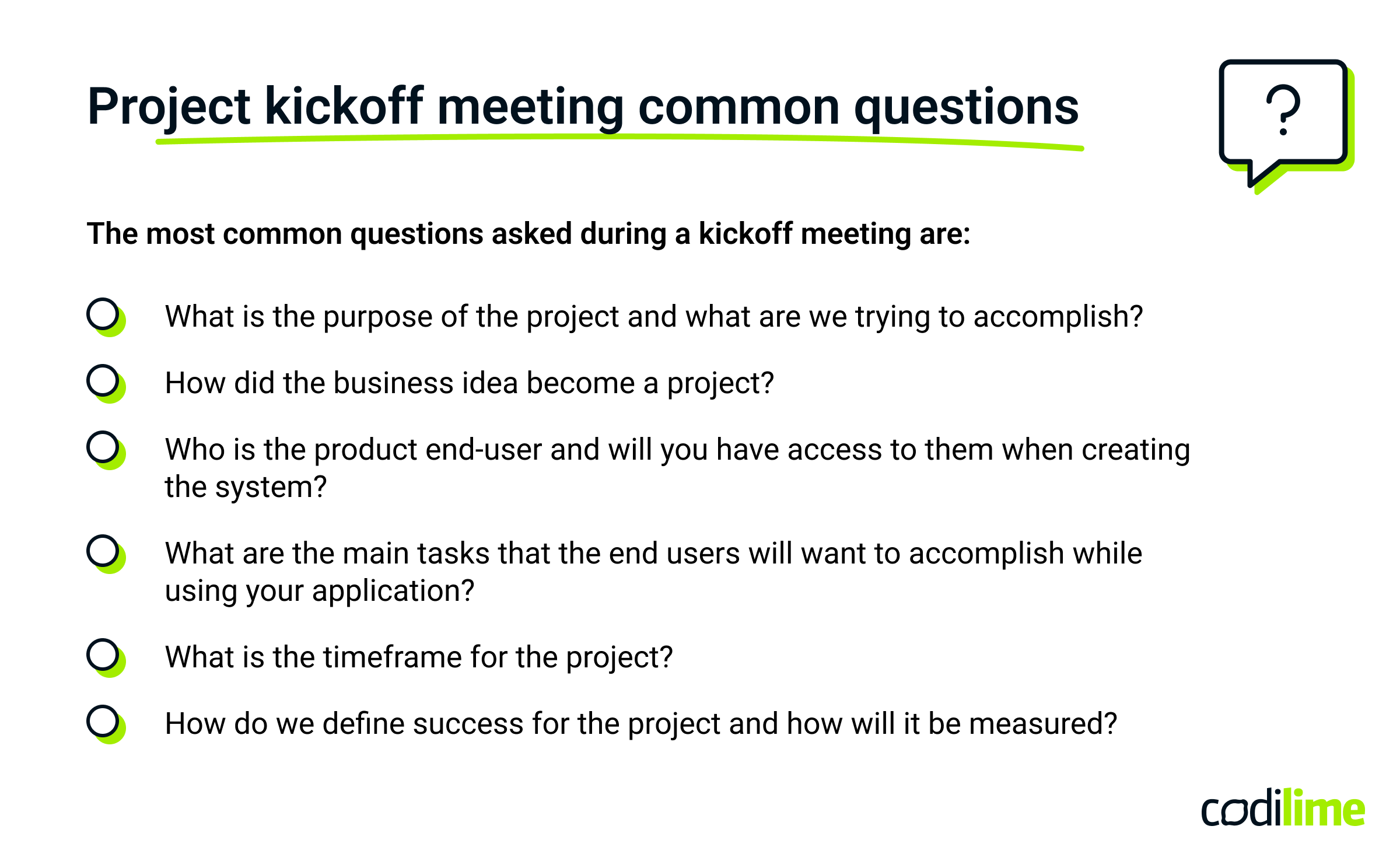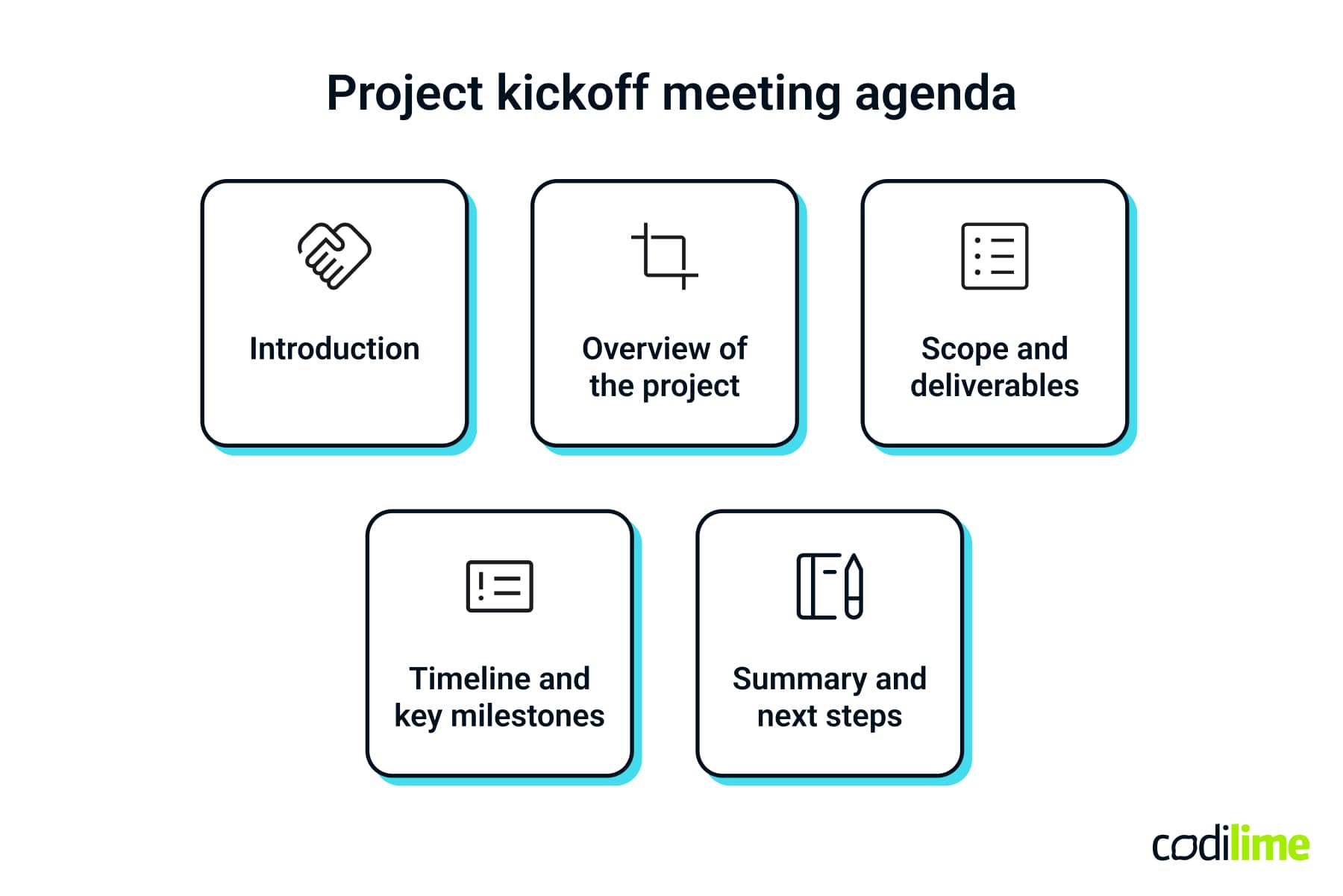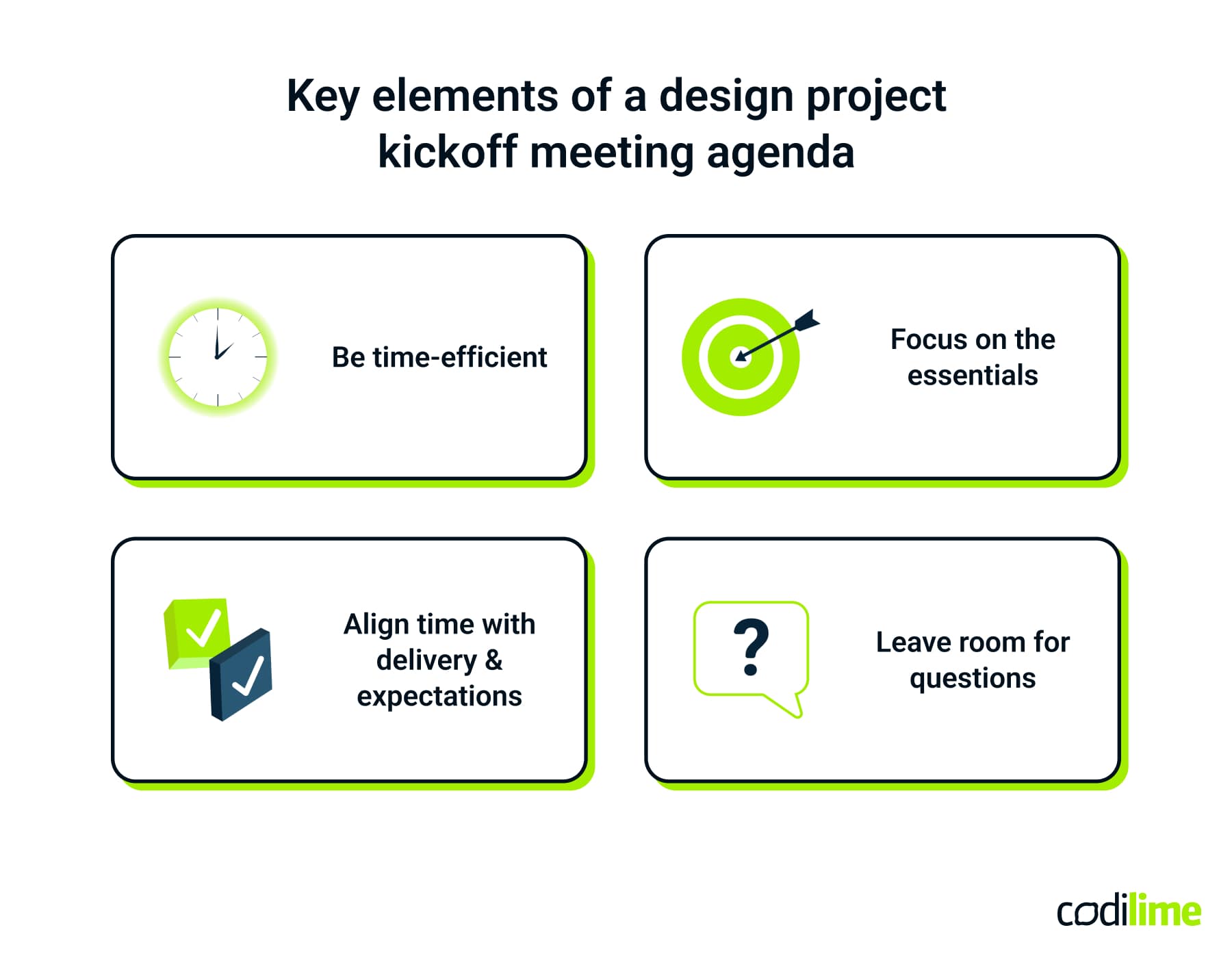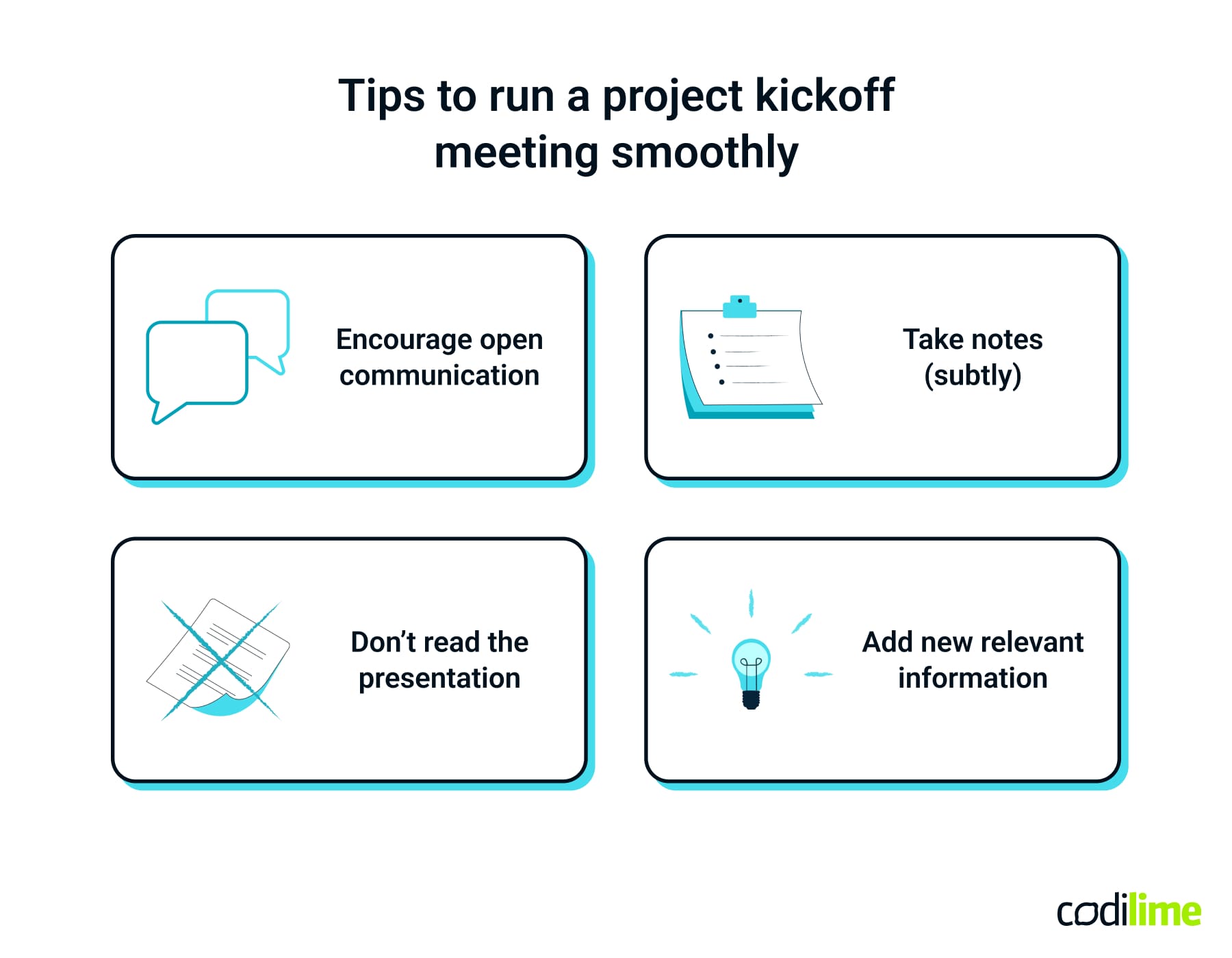The kickoff meeting is an essential stage of any software development process involving UI and UX design. After the ideation workshops, during which the software design and development team work hand in hand to understand and act upon the business requirements of the product, the kickoff meeting is the chance to agree on the strategy and tactics for a project’s success. So, what is the nature of this meeting, what goals should it meet and how should it be conducted to ensure a clear and efficient path for the work that has to be done?
What is a design project kickoff meeting?
A design project kickoff meeting is a crucial step in the planning and execution of any design project. It's the first official meeting where stakeholders, team members, and clients come together to define project goals, discuss the scope of work, establish timelines and budgets, and assign responsibilities.
This meeting sets the tone for the entire project, establishes communication protocols, and helps ensure that everyone involved is on the same page. In this section, we will explore what a design project kickoff meeting is, why it's essential, and how to plan and conduct an effective one.
The goal of a project kickoff meeting
The kickoff meeting’s primary goal is to create a clear path forward in the form of a project roadmap—a timeline of events and objectives (milestones) to meet business needs, discussed and confirmed with all of the project stakeholders.
The focus is on the project structure and workflow in which all involved roles and parties will operate. But that’s not the only reason why this meeting is essential. The kickoff meeting is also about creating a good relationship with your client in terms of cooperation and communication, which is an important design pillar. The meeting is a chance to better understand the client’s way of thinking on every stage of the project. It is also a time to build mutual trust based on your experience and deep understanding of your client’s business challenge.
Why is a project kickoff meeting important?
Getting the kickoff meeting right is essential as it sets the tone for the rest of your cooperation with the client. Insufficient and unclear communication about the needs and requirements can make the whole process much more difficult. This is especially true when working on complex systems and solutions that need proper understanding to better fulfill the product owner’s vision, and also cater to the very specific needs of users.
Who should attend the design project kickoff meeting?
The kickoff meeting is based on cooperation between the roles of a UX team. The product owner, designers and software developers all take part and raise questions. UX designers should collaborate with other team members to synchronize their contributions—not only is it a more efficient use of time, it presents a united appearance to the client.
Preparation for a project kickoff meeting
Before the kickoff meeting, you can prepare a set of questions which will help establish the future roadmap of the UX design process and to better understand the project requirements.
List all the questions needed
Base these questions on your current knowledge about the product your team will be developing. This part is especially essential if the first step of the software product development process in UX—ideation—hasn’t taken place or has been conducted without the involvement of a UX designer. If so, you should incorporate questions about the product’s business value proposition and target users into your kickoff agenda.
Project kickoff meeting common questions
The most common questions asked during a kickoff meeting are:
- What is the purpose of the project and what are we trying to accomplish?
- How did the business idea become a project?
- Who is the product end-user and will you have access to them when creating the system?
- What are the main tasks that the end-users will want to accomplish while using your application?
- What is the timeframe for the project?
- How do we define success for the project and how will it be measured?

List all the benchmarks needed
UX benchmarking is crucial for a successful product. Think about what you need to know about the product before you start the work and what could help you down the line. Additional topics that need clarification during this meeting are potential benchmarks (including in terms of visual design), and requirements on accessibility in design.
Pre-run the agenda with your team
Make sure to be aligned with your entire team, be it other UX designers, programmers, project managers, or other people on your side. Try a dry-run of the questions that you have prepared with the team—they might suggest something that you have not thought of, and this will also help them in setting up their own parts of the meeting agenda.
Learn to break the ice
Find out who the participants of the meeting will be. In the absence of a product owner, it will be your role to create an environment of trust between participants. You can do it by utilizing scrum master playbook techniques for “breaking the ice.” A good idea is to ask everyone to introduce themselves and say a few words about their expectations for the meeting.
Here, you can find more examples of why UX and UI design are important and worth investing in and why you should include them from the very beginning of the project.
What’s on a design project kickoff meeting agenda?
A design project kickoff meeting is an opportunity to align the project team and set expectations for the project's scope, timeline, deliverables, and general overview. Down below, you’ll find an exemplary agenda for a design project kickoff meeting:

Introduction
Begin by introducing all project team members and stakeholders present at the meeting and briefly describe their roles in the project.
Overview of the project
Provide an overview of the project's aim, goals, and objectives.
Scope and deliverables
Discuss the project's scope and the specific deliverables that are expected. This should include any constraints, such as deadlines, budget, or technical limitations.
Timeline and key milestones
Establish a timeline for the project and discuss any key issues that need to be addressed.
Summary and next steps
Summarize the most important details from the meeting, assign any action items, and set expectations for the next meeting.
Key elements of a design project kickoff meeting agenda
Every project kickoff meeting is different. The meeting’s direction depends on how complex the project is, the expectations of the stakeholders and participants, and how well-prepared you are to lead it to a satisfactory result.

You will find some tips on how to run a successful project kickoff meeting with your client below.
Be time-efficient
Make sure you use the allocated time efficiently. As a UX designer, you have a leading role in gathering essential information about the product to help your team deliver the project according to the client’s business needs.
Focus on the essentials
Make sure that your slide deck or presentation contains only essential information for the participants. Some topics might lead to larger discussions and these might need to be postponed for future meetings.
Align time with delivery & expectations
When working on an IT project, there are usually commonly practiced methodologies already selected, be it Agile/Scrum/Kanban, Lean, Waterfall, etc. You need to be clear on the amount of work you will be able to present at each step of the process and manage expectations from the beginning. Some projects have an abundance of time available, others are a clear-cut fight against time and/or budget—make sure you align with your client’s needs.
Leave room for questions
Allocate time for a Q&A session and specify the next steps after the meeting. Did you come across a topic that needs to be discussed further after the kickoff? If so, schedule time for that with all the necessary people. If everything else is sorted, close the meeting with a short summary of the next steps that you and your team will take.
Tips to run a project kickoff meeting smoothly

The kickoff meeting plays an essential role in the software development process. That is why you need to remember that the form and course of the meeting are as important as its goal. A few details that can help are:
Encourage open communication
Be as friendly as possible as this will allow for a more open discussion when it comes to setting up your collaboration. Starting the meeting with quick introductions from all the participants helps with this as well.
Take notes (subtly)
It’s always good practice to take quick notes, but try not to do so when the screen view is shared as this might distract people and possibly derail the thoughts of the person speaking. Making notes with pen and paper never gets old!
Don’t read the presentation
When going through your list of questions, make sure you’re not just reading off a script that people can see - hearing out loud exactly what is on the screen makes for a dull presentation and bores participants.
Add new relevant information
Be open and add secondary questions if something that the client says adds value or is worth following up on.
Common Pitfalls to Avoid in a Design Project Kickoff Meeting
The design project kickoff is a chance for stakeholders to discuss future expectations with the design team. The kickoff meeting sets the tone for the entire project, and it's important to make sure it's successful.

Unfortunately, there are some common pitfalls that can occur during a design kickoff meeting that can make the meeting unproductive or even derail the project. Here are some of the most common pitfalls to avoid:
Lack of preparation
Make sure that all meeting participants are prepared to discuss the project and have the relevant information at hand. Being adequately prepared is important to run a successful design kickoff meeting.
Unclear objectives
If you don’t establish specific project objectives, the meeting can become unproductive. It’s important to remember that everyone should understand the aim of the project, the target audience, the expected outcome, and stick to the project details.
Excluding potential risks
Overlooking potential risks and challenges that could arise during the project can lead to costly mistakes and delays. Develop strategies to mitigate these risks.
Poor communication
Good communication is a part of every successful project. Establishing a proper communication plan for the design project, including regular feedback sessions, updates, and check-ins, help to keep the project organized.
Failure to establish roles and responsibilities
It’s essential to establish the roles and responsibilities of each design kickoff meeting participant. This helps to ensure that everyone knows what is expected of them and can work together effectively. Failure to establish clear roles and responsibilities can result in confusion and misunderstandings, which can lead to ineffective outcomes.
Final thoughts
At the end of a successful kickoff meeting, your team should be ready to start the work as soon as it ends. The roadmap of the project should be established, the requirements should be discussed and clearly described to allow the team to take immediate action. Moreover, the client should be confident that their project is in the right hands. The trust built during a successful kickoff meeting will pay off throughout the whole process.








